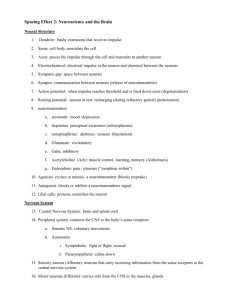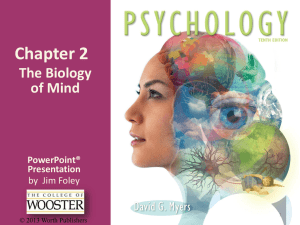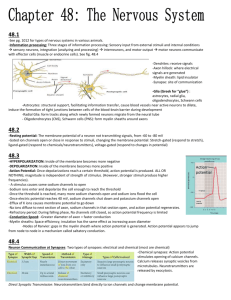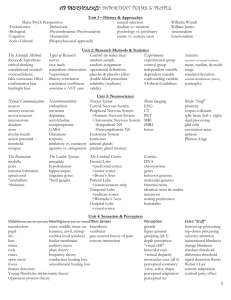AP Psychology Unit III: Biological Bases of Behavior 3rd Period
advertisement
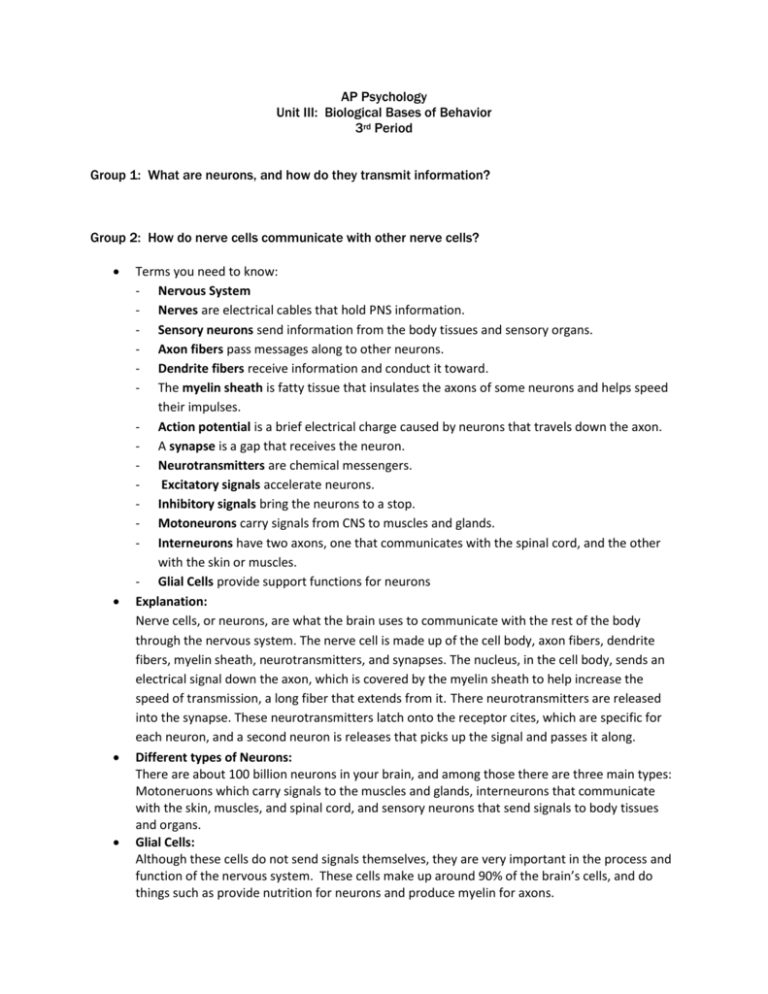
AP Psychology Unit III: Biological Bases of Behavior 3rd Period Group 1: What are neurons, and how do they transmit information? Group 2: How do nerve cells communicate with other nerve cells? Terms you need to know: - Nervous System - Nerves are electrical cables that hold PNS information. - Sensory neurons send information from the body tissues and sensory organs. - Axon fibers pass messages along to other neurons. - Dendrite fibers receive information and conduct it toward. - The myelin sheath is fatty tissue that insulates the axons of some neurons and helps speed their impulses. - Action potential is a brief electrical charge caused by neurons that travels down the axon. - A synapse is a gap that receives the neuron. - Neurotransmitters are chemical messengers. Excitatory signals accelerate neurons. - Inhibitory signals bring the neurons to a stop. - Motoneurons carry signals from CNS to muscles and glands. - Interneurons have two axons, one that communicates with the spinal cord, and the other with the skin or muscles. - Glial Cells provide support functions for neurons Explanation: Nerve cells, or neurons, are what the brain uses to communicate with the rest of the body through the nervous system. The nerve cell is made up of the cell body, axon fibers, dendrite fibers, myelin sheath, neurotransmitters, and synapses. The nucleus, in the cell body, sends an electrical signal down the axon, which is covered by the myelin sheath to help increase the speed of transmission, a long fiber that extends from it. There neurotransmitters are released into the synapse. These neurotransmitters latch onto the receptor cites, which are specific for each neuron, and a second neuron is releases that picks up the signal and passes it along. Different types of Neurons: There are about 100 billion neurons in your brain, and among those there are three main types: Motoneruons which carry signals to the muscles and glands, interneurons that communicate with the skin, muscles, and spinal cord, and sensory neurons that send signals to body tissues and organs. Glial Cells: Although these cells do not send signals themselves, they are very important in the process and function of the nervous system. These cells make up around 90% of the brain’s cells, and do things such as provide nutrition for neurons and produce myelin for axons. Group 3: How do neurotransmitters influence behavior, and how do drugs and other chemicals affect neurotransmission? Neurotransmitters are chemicals located and released in the brain to allow an impulse from one nerve cell to pass to another nerve cell. there are many types of neurotransmitter such as, acetylcholine, norepinephrine, dopamine and serotonin. seritonin is a neurotransmitter that involves feelings, mood, appetite, sleep and muscle contraction as well as functions involved in memory and learning, which in turn will directly affect behavior. if there is an abnormality in certain neurotransmitters it can lead to many mental disorders. Disorders caused by abnormality in neurotransmitters: o interrupted neurotransmitters (problems with messages being sent between them) can cause depression o disconnect between neurotransmitters can cause problems with mood swings and can lead to aggression and anxiety o disruption with serotonin and norepinephrine can lead to anxiety disorders and depression o if dopamine is altered it can lead to severe mental disorders such as schizophrenia o dopamine can if affected can cause ADHD o other mental disorders such as dissociative identity disorder, all personality disorders and antisocial disorder Drugs and Neurotransmitters: Drugs can directly influence the messages between neurotransmitter and cause many disorders as well. the dependency and addiction that people develop to drugs in an effect of a brain disease caused y the abuse of drugs because of how they alter neurotransmitters. drugs such as stimulants increase the amount of dopamine in the brain and block the messages once the drug has worn off. this causes people to become addicted because they crave the elated feelings they receive from the drug. Drugs causing mental disorders: o mental health disorders and substance abuse are often treated together because one makes you more vulnerable to the other o the mental vulnerability caused by drugs makes a person much more likely to cause mental disorders o the most common disorder caused by drug use is bipolar disorder o alcoholism is the leading cause of bipolar disorder in adults especially women o drug-induced psychosis is a common side effect of drug abuse Group 4: What are the functions of the nervous system’s main divisions? The nervous system is our body’s speedy electrochemical information network. The nervous system is broken down into 2 main divisions, the central nervous system and the peripheral nervous system. The central nervous system is the basis for all the mental and behavioral activities. It contains roughly 99% of all the neurons in our body. The CNS has two main body parts in it, the brain and the spinal cord. The brain carries out the higher, more complex mental and behavioral activities, while the spinal cord carries out the simpler levels of behavioral organization. The spinal deals primarily with reflexes, such as the knee-jerk response and the pain flex, like putting your finger in a candle flame. The brain runs as almost a computing machine, it receives slightly different images of an object, computes the object and can infer how far the object is from you. The CNS is protected by 3 layers of connective tissues called meninges that are around the spinal cord and brain. The CNS, like stated before, has many different types of neurons in our body. The sensory neurons, for example, send information from the body’s tissues and sensory organs inward to the CNS brain and spinal cord that then process the information. Then the CNS sends the instructions out to the body’s tissues via the motor neurons. The other major part of the nervous system is the Peripheral nervous system, which has two subdivisions. The PNS is made up of neurons that lie outside of the brain and spinal cord. One of the subdivions of the PNS is the somatic nervous system. This system is consisted of Peripheral nerve fibers that send sensory information to the central nervous system and motor nerve fibers that protect the skeletal muscles. The other subdivision of the PNS, which also has a subdivision of its own, is called the autonomic system. It controls the glands and the muscles of our internal organs. It works on automatic pilot(for the most part). It operates on its own to influence our internal functioning, including our heartbeat, digestion and our glandular activity. The sympathetic nervous system, the ally of the autonomic system is there to accelerate our heartbeat, raise our blood pressure and slow our digestions whenever you get nervous or alarm, for things such as job interviews or making public speeches. Group 5: How does the endocrine system – the body’s slower information system – transmit its messages? The endocrine system is a set of glands that secrete hormones into the bloodstream, where they travel through the body and affect other tissues, including the brain. In an intricate feedback system, the brain’s hypothalamus influences the pituitary gland influences other glands (such as adrenals) to release hormones, which in turn influences the brain. The endocrine system’s master gland, pituitary gland, influences hormone release by other glands. The foundations of the endocrine system are the hormones and glands. They use hormones, chemical messengers, to travel through the bloodstream to send instructions from cell to cell. These hormones are released through glands, which are just a cluster of cells, to secrete the chemicals. Broadcasts its hormonal messages to essentially all cells by secretion into blood and other fluids and bind to receptors in order for there to be a response. Hormones are the chemical messengers secreted into the blood by one cell that affect the functioning of other cells. Most hormones circulate in blood, coming into contact with essentially all cells. Usually a hormone affects a limited number of cells, called target cells. The target cells responds to a hormone because it has receptors for that hormone. Cells for that don’t have those receptor cells cannot be influenced directly by that hormone. When that hormone binds to the receptor it creates reactions in the cell that causes the function. The endocrine system’s glands secrete hormones. Hormones originate in one tissue, travel through the bloodstream, and affect other tissues. These endocrine messages are slow but worth the wait because their effects usually outlast the effects of a neural message. Group 6: How do neuroscientists study the brain’s connections to behavior and mind? Neuroscientists specialize in the study of brain and nervous system and want to understand the billions of nerve cells and how they are born, grow, and are connected. They are also concerned about how the cells organize themselves into effective, functional circuits that remain in order to enable us to read, speak, form relationships, motivate us, etc. Ways neuroscientists analyze behavior and mind via the brain: - MRI (magnetic resonance imaging): magnetic field scans show brain structures and give images of brain tissue - EEG (electroencephalogram): measures electric activity between neurons by amplifying waves. - PET (positron emission tomography): scan shows each brain area’s intake of chemical fuel (ex. Sugar or glucose) and where “food for thought” goes. - fMRI (functional magnetic resonance imaging): detects function of the brain and detects blood rushing to certain parts of the brain as the person looks at something that can stimulate a response. Different kinds of emotions, perceptions, images and thoughts may be detected from brain activity when mental tasks are performed. - SPECT Scan (single photon emission computerized tomography): shows 3d images of brain activity to measure brain metabolism and blood flow; allows neuroscientists to identify brain patterns that correlate with psychiatric and neurological illnesses. Group 7: What are the functions of important lower-level brain structures? Group 8: What functions are served by the various cerebral cortex regions? I. Cerebral Cortex a. Outer layer of the cerebrum’s tissue, folded b. Separated into two hemispheres: left and right c. Each hemisphere further divided into four main lobes: parietal, occipital, temporal, frontal d. Lobes have certain functions i. Frontal: speaking, movement, judgment, abstract reasoning, planning, memories of actions, language association II. III. IV. V. ii. Parietal: touch, movements with a goal iii. Occipital: vision, other vision-related tasks (registering movement, determining color) iv. Temporal: hearing, long term memory, some emotions, language processing e. Within lobes, further divisions into even more specialized areas (ex. motor cortex) Visual Cortex and Auditory Cortex a. Visual cortex i. Found in very back of occipital lobe ii. Left hemisphere visual cortex receives info from right side of vision field, vice versa iii. Blindness can result from injuring this area b. Auditory cortex i. Found in temporal lobe ii. Info from one ear processed by cortex on opposite hemisphere iii. Ex. left ear goes to right hemisphere auditory cortex iv. Active when nonexistent sounds are perceived Broca’s area, Wernicke’s area, angular gyrus a. Broca’s and Wernicke’s areas may be found in different regions from person to person i. Broca’s area typically in left frontal lobe ii. Wernicke’s area typically in left temporal lobe b. Angular gyrus found in parietal lobe, one in right, one in left c. Each area was found to cause different aphasias (impaired use of language) i. Damage to Broca’s area: unable to speak ii. Damage to Wernicke’s area: unable to understand iii. Damage to angular gyrus: unable to read d. Normal language functions (reading, speaking, comprehending, etc.) involve cooperation/communication of all areas Association areas i. The portions of the cerebral cortex not involved in any of the body’s sensory or muscular activity ii. Comprise 3/4 of the entire cortex iii. Engage in interpreting and transmitting information from the 4 sensory lobes iv. Complex abilities come from coordination of many AAs 1. Ex. development of ability to speak and memorize a foreign language b. Frontal lobe AA i. Promotes judgment, planning and registration of new memories ii. Damage to frontal lobes: more coherent memory & ability to score well on intelligence tests iii. Damage may alter one’s personality and hamper ability to tell right from wrong 1. Ex. children with defective frontal lobes tend to lie and steal more than normal kids & grow up to become abusive adults c. Parietal lobe AA i. Vital for mathematical reasoning d. Temporal lobe AA i. Helps one recognize faces ii. Damage still enables one to identify another’s face The Sensory Cortex’s role in the Brain’s Plasticity a. Plasticity: the brain’s ability to modify itself after enduring damage b. Neural tissue reorganize in response to damage c. Mostly occurs after severe damage VI. i. Ex. if a person loses a finger, their sensory cortex receives the message and starts relying on their other fingers to sense and feel d. Damage not necessarily the reason plasticity occurs i. Ex. professional pianists may have a larger area of the auditory cortex, which processes the piano’s sounds better than usual e. Sensory cortex’s interaction with brain plasticity has great benefits in blind and deaf i. Ex. when a blind person reads Braille with one finger, the brain area connected to that finger expands, linking the person’s sense of touch to their sense of vision Motor Cortex and Sensory Cortex a. Motor cortex i. Located at the back of the frontal lobe ii. Runs from ear to ear across the top of the brain iii. Involved in planning, control, and execution of voluntary movements iv. When a specific region in the left or right hemisphere is stimulated, specific body parts move on the opposite side of the body v. Damage or lesions to the motor cortex can lead to paralysis or difficulty with voluntary motor control b. Sensory cortex: i. Located at the front of the parietal lobes ii. Registers and processes body touch and movement sensations iii. The more sensitive a body region, the larger the areas of the sensory cortex devoted to it 1. Ex. Your lips project to a larger brain area than do your toes. Group 9: What do split brains reveal about the functions of our two brain hemispheres? Split Brain- Condition in which the two hemispheres of the brain are isolated by cutting the connecting fibers (mainly those of the Corpus Callosum) between them. The left hemisphere specializes in: The right hemisphere specializes in: Spatial Abilities Language Face Recognition Math Visual Imagery Logics Music Corpus Callosum- Structure in brain along the fissure that facilitates much of the communication between the two hemispheres. Corpus Colostomy- Procedure, in which the Corpus callosum is sectioned, resulting in a partial or complete disconnection between the hemispheres. Also most of the information between the hemispheres is lost.


